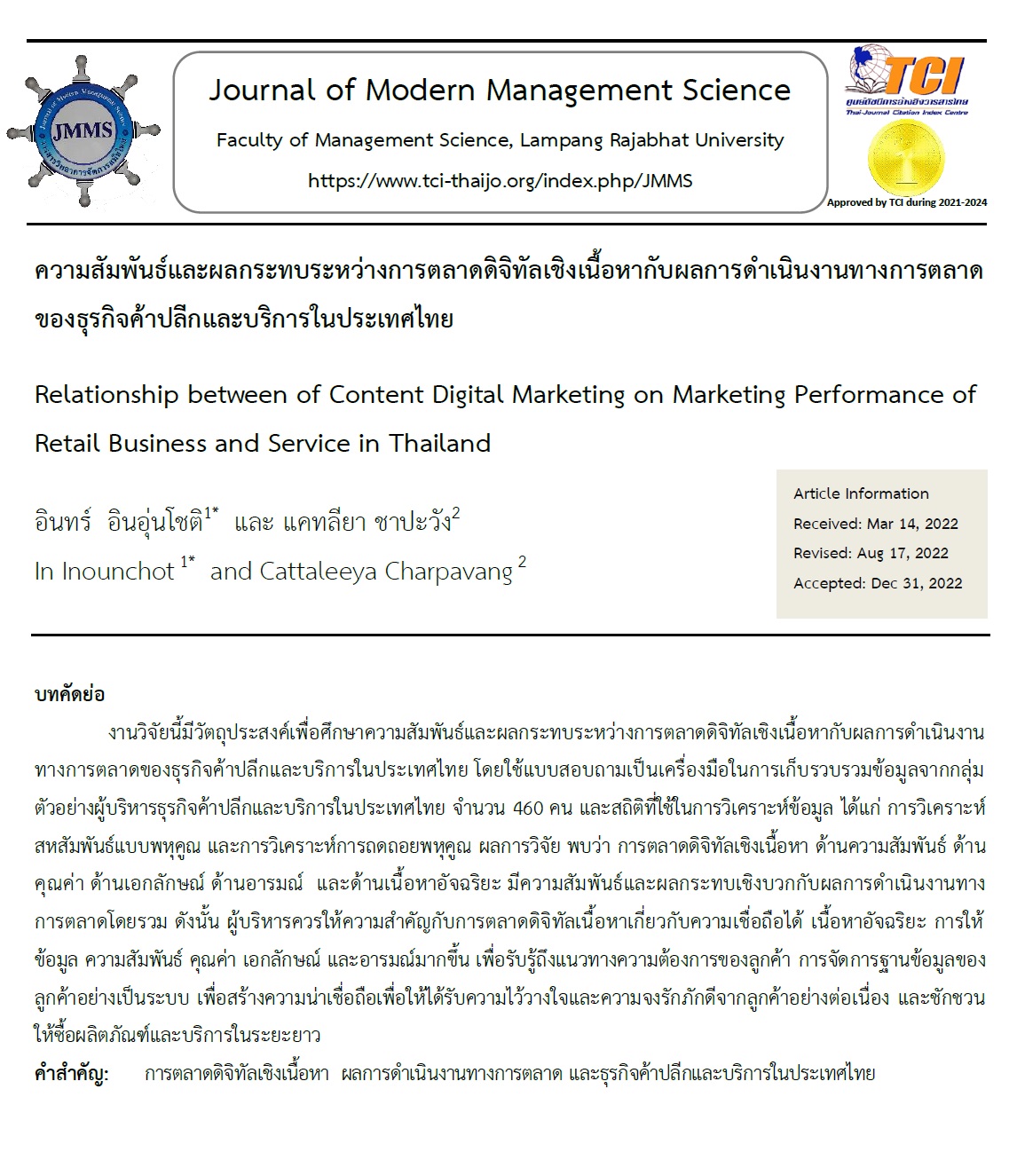ความสัมพันธ์และผลกระทบระหว่างการตลาดดิจิทัลเชิงเนื้อหากับผลการดำเนินงานทางการตลาดของธุรกิจค้าปลีกและบริการในประเทศไทย
Main Article Content
บทคัดย่อ
งานวิจัยนี้มีวัตถุประสงค์เพื่อศึกษาความสัมพันธ์และผลกระทบระหว่างการตลาดดิจิทัลเชิงเนื้อหากับผลการดำเนินงานทางการตลาดของธุรกิจค้าปลีกและบริการในประเทศไทย โดยใช้แบบสอบถามเป็นเครื่องมือในการเก็บรวบรวมข้อมูลจากกลุ่มตัวอย่างผู้บริหารธุรกิจค้าปลีกและบริการในประเทศไทย จำนวน 460 คน และสถิติที่ใช้ในการวิเคราะห์ข้อมูล ได้แก่ การวิเคราะห์สหสัมพันธ์แบบพหุคูณ และการวิเคราะห์การถดถอยพหุคูณ ผลการวิจัย พบว่า การตลาดดิจิทัลเชิงเนื้อหา ด้านความสัมพันธ์ ด้านคุณค่า ด้านเอกลักษณ์ ด้านอารมณ์ และด้านเนื้อหาอัจฉริยะ มีความสัมพันธ์และผลกระทบเชิงบวกกับผลการดำเนินงานทางการตลาดโดยรวม ดังนั้น ผู้บริหารควรให้ความสำคัญกับการตลาดดิจิทัลเนื้อหาเกี่ยวกับความเชื่อถือได้ เนื้อหาอัจฉริยะ การให้ข้อมูล ความสัมพันธ์ คุณค่า เอกลักษณ์ และอารมณ์มากขึ้น เพื่อรับรู้ถึงแนวทางความต้องการของลูกค้า การจัดการฐานข้อมูลของลูกค้าอย่างเป็นระบบ เพื่อสร้างความน่าเชื่อถือเพื่อให้ได้รับความไว้วางใจและความจงรักภักดีจากลูกค้าอย่างต่อเนื่อง และชักชวนให้ซื้อผลิตภัณฑ์และบริการในระยะยาว
Article Details

อนุญาตภายใต้เงื่อนไข Creative Commons Attribution-NonCommercial-NoDerivatives 4.0 International License.
บทความจะต้องผ่านการพิจารณายอมรับให้ตีพิมพ์ได้โดยกองบรรณาธิการของวารสารการจัดการ คณะวิทยาการ มหาวิทยาลัยราชภัฎลำปาง และได้รับการตรวจอ่านโดยผู้ทรงคุณวุฒิ(Peer review) และผู้เขียนบทความต้องปรับปรุงตามข้อเสนอแนะหากมีก่อนตีพิมพ์ บทความที่ไม่ผ่านการพิจารณา กองบรรณาธิการจะแจ้งให้ทราบผลการพิจารณา แต่จะไม่ส่งต้นฉบับคืนผู้เขียน
วารสารวิทยาการจัดการสมัยใหม่ คณะวิทยาการจัดการ มหาวิทยาลัยราชภัฏลำปาง ตีพิมพ์เผยแพร่ทั้งฉบับพิมพ์และฉบับออนไลน์ เราอนุญาตให้นำบทความไปใช้ประโยชน์ทางวิชาการได้ ภายใต้ขอบเขตของกฏหมายลิขสิทธิ์
เอกสารอ้างอิง
กรมพัฒนาธุรกิจการค้า. (2563). ข้อมูลทั่วไปผู้ประกอบการธุรกิจค้าปลีกและบริการในประเทศไทย. [ออนไลน์]. สืบค้นเมื่อวันที่ 20 กันยายน 2563 เข้าถึงจาก https://www.dbd.go.th/
บริษัท พีเอ็มจี คอร์ปอเรชั่น จำกัด. (2562). Smart SME รวมข้อมูลข่าวสาร เพื่อธุรกิจเอสเอ็มอี. กรุงเทพฯ: บริษัท พีเอ็มจี คอร์ปอเรชั่น จำกัด.
พรพรรณ ตาลประเสริฐ. (2562). อิทธิพลของการตลาดแบบดิจิทัลต่อการตัดสินใจซื้อของผู้บริโภคกลุ่มธุรกิจการพาณิชย์อิเล็กทรอนิกส์ในเขตจังหวัดกรุงเทพมหานคร. วิทยานิพนธ์บริหารธุรกิจมหาบัณฑิต มหาวิทยาลัยกรุงเทพ.
ราม ปิยะเกตุ มาโนช โลหเตปานนท์ และธวัชชัย ชรินพาณิชกุล. (2564). โครงการศึกษาวิเคราะห์พัฒนาการของ ผู้ประกอบการพาณิชย์อิเล็กทรอนิกส์. กรุงเทพฯ: เนชั่น,
ราม ปิยะเกตุ, พิสุทธิ์ เพียรมนกุล, มาโนช โลหเตปานนท์, ธวัชชัย ชรินพาณิชกุล และชัยเชษฐ์ สายวิจิตร. (2555). วิเคราะห์พัฒนาการของผู้ประกอบการธุรกิจค้าปลีกและค้าส่งในประเทศไทย. กรุงเทพฯ: เนชั่น,
ศูนย์วิเคราะห์เศรษฐกิจทีเอ็มบี. (2564). ธุรกิจค้าปลีกกับช่องทางออนไลน์เชื่อมต่อผู้บริโภค. กรุงเทพฯ: ศูนย์วิเคราะห์เศรษฐกิจทีเอ็มบี.
ศูนย์วิจัยกสิกรไทย. (2563). เศรษฐกิจไทยไตรมาส 2/2563 คาดหดตัวลุกสุดในปีนี้ แต่ครึ่งปีหลังยังคงมีความเสี่ยงสูงและยังต้องติดตามมาตรการเพิ่มเติม (มองเศรษฐกิจ ฉบับที่ 3880). กรุงเทพฯ : ศูนย์วิจัยกสิกรไทย.
สำนักงานนวัตกรรมแห่งชาติ. (2564) . แนวโน้มการขยายตัวทางเศรษฐกิของประเทศไทย. กรุงเทพฯ: สำนักงานนวัตกรรมแห่งชาติ.
สุภาภรณ์ อุดมลักษณ์. (2560). การพัฒนารูปแบบการบริหารจัดการการใช้เทคโนโลยี สารสนเทศและการสื่อสาร ของวิทยาลัยพยาบาล สังกัดสถาบันพระบรมราชชนก, Nursing Journal of The Ministry of Public Health, 27(1), 113-125.
อโณทัย งามวิชัยกิจ. (2563). การสื่อสารการตลาดผ่านสื่อสังคมที่มีผลต่อความผูกพันของนักศึกษาต่อตราผลิตภัณฑ์มหาวิทยาลัย กรณีศึกษามหาวิทยาลัยสุโขทัยธรรมาธิราช, วารสารวิชาการนวัตกรรมสื่อสารสังคม. 7(2) : 94-105.
Aaker, D. A. (2001). Consumer Evaluations of Brand Extensions, Journal of Marketing, 54(1), 27–41.
Abel, U. (2014). Benson, Cutting-Edge Technologies and Social Media Use in Higher Education. International Journal of Information Management, 24(1), 236-252.
Ambler, T., & Kokkinaki, F. (2014). Measures of marketing success. Journal of Marketing Management, 13(7), 37-41.
Ausra, K. & Ruta, M. (2016). Biotechnological Wastewater Treatment in Small-scale Wastewater Treatment Plants, Journal of Cleaner Production. 279, 123750.
Berger, B. and Milkman, G. (2010). The Process of Customer Engagement: A Conceptual Framework. The Journal of Marketing Theory and Practice, 17(1), 63–74.
Berkle, B.J. (2010). Analyzing Service Blueprints Using Phase Distributions. European Journal of Operational Research, 88(1), 152-164.
Bertrand, M., Goldin, C. & Katz, L. (2010). Dynamics of the Gender Gap for Young Professionals in the Financial and Corporate Sectors. American Economic Journal Applied Economics, 2(3), 228-55.
Black, K. (2006). Business Statistics for Contemporary Decision Marking. (4th ed.) USA : John Wiley & Sons. pp. 585.
Cernikovaite, J. (2012). Digital Content Marketing's Role in Fostering Consumer Engagement, Trust, and Value: Framework, Fundamental Propositions, and Implications. Journal of Interactive Marketing, 45, 27-41.
Chasser, T. K., Zheng, X., Christy, C. & Lee, O. (2010). Antecedents and Consequences of Customer Engagement in Online Brand Communities. Journal of Marketing Analytics, 2(2), 81–97.
Gagnon, J. (2014). Demographic Change and the Future of the Labour Force in the EU27, in other OECD Countries and Selected Large Emerging Economies. Matching Economic Migration with Labour Market Needs, OECD Publishing, Paris.
Hanbury, K. (2015). Steps to Creating an Effective Content Mix. The Journal of Marketing Theory and Practice, Retrieved from http://contentmarketinginstitute.com/2011/02/content-mix/
Javornik, A., Raffaele, F. & Gumann, R. (2020). Don't Forget that Others Are Watching, Tool. The Effect of Conversational Human Voice and Reply Length on Observers' Perceptions of Complaint Handling in Social Media. Journal of Interactive Marketing, 50, 100-119.
Kapoor, E., Johanne, M. P., Lajeunesse, D., Pelletier, J. P. & Fahmi, H. (2018). Role of Prion Flam Matory Cytokines in the Pathophysiology of Osteoarthritis. Nature Reviews Rheumatology, 7, 33–42.
Kaur, K. L., Hong-Bumm, K., Woo G. K. and Jeong A. (2018). Strategic Brand Online : Building, Measuring, and Managing Brand Equity. (2nd ed.) Englewood Cliffs, NJ., Prentice Hall.
Lal, M., Wang, W. H. and Jillian, D. & Farquhar, S. (2020). Soil Carbon Sequestration Impacts on Global Climate Change and Food Security. Journal of Interactive Marketing, 52(3), 99-117.
Limba, J. (2013). Trust and Power: Two Works by Niklas Luhman. New York: John Wiley & Sons.
Lin, R. J., Lewicki, R.J., McAllister, D.J. & Bies, R.J. (2014). Trust and Distrust: New Relationships and Digital Marketing. The Academy of Management Review, 23(3), 438-459.
Ludwig, J., Liebman, J.B., Kling, J.R., Duncan, G.J. Katz, L.F. & Kessler, R.C. (2012). What Can We Learn about Neighborhood Effects from the Moving to Opportunity Experiment. American Journal of Sociology, 114, 144–188.
Nunnally, J.C. (1978). Psychometric Theory. (2nd ed.) McGraw-Hill, New York.
Ruzkevicius, R. & Guseva, G. (2006). Generalized Expectancies for Interpersonal Trust. American Psychologist, 26(5), 443-452.
Statista, S. (2020). Examining Relational Digital Transformation Through the Unfolding of Local Practices of the Finnish Taxi Industry. The Journal of Strategic Information System, 29(3), 101622.
Wertime, K. & Fenwick, I. (2017). Open Word on Digital Marketing. New York: Price.
Wolf, N. (2010). Marketing to win: Strategies for building competitive advantage in service industries: Frank K. Sonnenberg Grand Rapids: Harper Business. Public Relations Review, 17(2), 205-206.
Zhao, S., Zhang, J. & Leeb, J. (2021). Internet Market Strategies: Antecedents and Implications. Information and Management, 43(2), 222-238.


